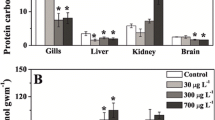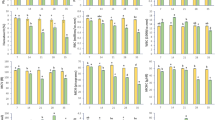Abstract
This study was conducted to characterize the alterations in reduced glutathione (GSH) level, catalase (CAT) activity and proteins electrophoretic patterns in response to sublethal copper (Cu) exposure in Cyprinus carpio and to determine whether these responses are related to Cu accumulation in gills, chosen as target tissue. Fish were exposed to 0.1 and 1.0 mg/l Cu for 10 and 20 days. There were increasing level of Cu in the gill with increasing concentrations of metal in the exposure medium, and with increasing duration of exposure. GSH level and CAT activity increased in fish exposed to 1.0 mg/l Cu for both exposure periods, while no change was detected at the lower Cu concentration. Electrophoretic patterns of gill proteins by sodium dodecyl sulphate gel electrophoresis (SDS–PAGE) consist of 25-, 26-, 30-, 44- and 48-kDA medium molecular weight proteins (MMP) for five bands and 64-, 72-, 90- and 101-kDA high molecular weight proteins (HMP) for four bands in both control and treatment groups. The levels of 25-, 26- and 30-kDA MMP and 72- and 90-kDA HMP increased in response to Cu exposure. The present study demonstrated that Cu caused stress in fish gills and an acclimation with induction of GSH, CAT, MMP and HMP, which were important in the protection against metal damage, was observed.



Similar content being viewed by others
References
Andersen R, Frazier J, Huang PC (1986) Transition metal-binding proteins from three Chesapeake Bay fish species. Environ Health Perspect 65:149–156
Atli G, Canli M (2007) Enzymatic responses to metal exposures in a freshwater fish Oreochromis niloticus. Comp Biochem Physiol 145C:282–287
Atli G, Canli M (2008) Responses of metallothionein and reduced glutathione in a freshwater fish Oreochromis niloticus following metal exposures. Environ Toxicol Pharmacol 25:33–38
Azevedo M-M, Carvalho A, Pascoal C, Rodrigues F, Cassio F (2007) Responses of antioxidant defenses to Cu and Zn stress in two aquatic fungi. Sci Tot Environ 377:233–243
Basha PS, Rani AU (2003) Cadmium-induced antioxidant defense mechanism in freshwater teleost Oreochromis mossambicus (Tilapia). Ecotox Environ Saf 56:218–221
Beutler E (1975) Red cell metabolism: a manual of biochemical methods, 2nd edn. Grune and Stration Company, New York
Carvalho CS, Fernandes MN (2008) Effect of copper on liver key enzymes of anaerobic glucose metabolism from freshwater tropical fish Prochilodus lineatus. Comp Biochem Physiol 151A:437–442
Das BK, Das N (2005) Impacts of quicklime (CaO) on the toxicity of copper (CuSO4, 5H2O) to fish and fish food organisms. Chemosphere 61:186–191
Dautremepuits C, Paris-Palacios S, Betoulle S, Vernet G (2004) Modulation in hepatic and head kidney parameters of carp (Cyprinus carpio L.) induced by copper and chitosan. Comp Biochem Physiol 137C:325–333
De Boeck G, Ngo TTH, Van Campenhout K, Blust R (2003) Differential metallothionein induction patterns in three freshwater fish during sublethal copper exposure. Aquat Toxicol 65:413–424
De Boeck G, Meeus W, De Coen W, Blust R (2004) Tissue-specific Cu bioaccumulation patterns and differences in sensitivity to waterborne Cu in three freshwater fish: rainbow trout (Oncorhynchus mykiss), common carp (Cyprinus carpio), and gibel carp (Carassius auratus gibelio). Aquat Toxicol 70:179–188
De Smet H, Blust R (2001) Stress responses and changes in protein metabolism in carp Cyprinus carpio during cadmium exposure. Ecotox Environ Saf 48:255–262
Durou C, Poirier L, Amiard J-C, Budzinski H, Gnassia-Barelli M, Lemenach K, Peluhet L, Mouneyrac C, Romeo M, Amiard-Triquet C (2007) Biomonitoring in a clean and a multi-contaminated estuary based on biomarkers and chemical analyses in the endobenthic worm Nereis diversicolor. Environ Pollut 148:445–458
Dutta HM, Arends DA (2003) Effects of endosulfan on brain acetylcholinesterase activity in juvenile bluegill sunfish. Environ Res 91:157–162
Fırat Ö (2007) Effects of metal (Zn, Cd) and metal mixtures (Zn + Cd) on physiological and biochemical parameters in blood tissue of Oreochromis niloticus. Ph.D. Thesis, Institute of Basic and Applied Sciences, Cukurova Univ, Adana, pp 1–248
Fırat Ö, Çogun HY, Aslanyavrusu S, Kargın F (2009) Antioxidant responses and metal accumulation in tissues of Nile Tilapia Oreochromis niloticus under Zn, Cd and Zn + Cd exposures. J Appl Toxicol 29:295–301
Freedman JH, Ciriolo MR, Peisach J (1989) The role of glutathione in copper metabolism and toxicity. J Biol Chem 264:5598–5605
Gallego A, Martin-Gonzalez A, Ortega R, Gutierrez JC (2007) Flow cytometry assessment of cytotoxicity and reactive oxygen species generation by single and binary mixtures of cadmium, zinc and copper on populations of the ciliated protozoan Tetrahymena thermophila. Chemosphere 68:647–661
Gao Y, Chen C, Zhang P, Chai Z, He W, Huang Y (2003) Detection of metalloproteins in human liver cytosol by synchrotron radiation X-ray fluorescence after sodium dodecyl sulphate polyacrylamide gel electrophoresis. Anal Chim Acta 485:131–137
Guimaraes-Soares L, Felicia H, Bebianno MJ, Cassio F (2006) Metal-binding proteins and peptides in the aquatic fungi Fontanospora fusiramosa and Flagellospora curta exposed to severe metal stress. Sci Tot Environ 372:148–156
Halliwell B, Gutteridge JMC (1999) Free radicals in biology and medicine. Clarendon Pres, Oxford
Hammer DH (1986) Metallohionein. Annu Rev Biochem 55:913–951
Hansen BH, Rømma S, Garmo ØA, Pedersen SA, Olsvik PA, Andersen RA (2007) Induction and activity of oxidative stress-related proteins during waterborne Cd/Zn-exposure in brown trout (Salmo trutta). Chemosphere 67:2241–2249
Heath AG (1995) Water pollution and fish physiology. Boca Raton, CRC press, pp 141–170
Hermesz E, Abraham M, Nemcsok J (2001) Tissue-spesific expression of two metallothionein genes in common carp during cadmium exposure and temperature shock. Comp Biochem Physiol 81C:139–143
Hollis L, Hogstrand C, Wood CM (2001) Tissue-specific cadmium accumulation, metallothinein induction, and tissue zinc and copper levels during chronic sublethal cadmium exposure in juvenile rainbow trout. Arch Environ Contam Toxicol 41:468–474
Kito H, Ose Y, Sato T (1986) Cadmium-binding protein (metallothioneins) in carp. Environ Health Perspect 65:117–124
Laemmli UK (1970) Cleavage of structural proteins during the assembly of the head of bacteriophage T4. Nature 227:680–685
Lange A, Ausseil O, Segner H (2002) Alterations of tissue glutathione levels and metallothionein mRNA in rainbow trout during single and combined exposure to cadmium and zinc. Comp Biochem Physiol 131C:231–243
Lowry OH, Rosebrough NJ, Farra NJ, Randall RJ (1951) Protein measurements with the folin phenol reagent. J Biol Chem 193:265–275
Mates JM (2000) Effects of antioxidant enzymes in the molecular control of reactive oxygen species toxicology. Toxicology 153:83–104
McDonald DG, Wood CM (1993) Branchial mechanisms of acclimation to metals in freshwater fish. In: Rankin JC, Jensen FB (eds) Fish Echophisology. Chapman and Hall, London, pp 297–321
Menezes MR, Qasim SZ (1984) Effects of mercury accumulation on the electrophoretic patterns of the serum, haemoglobin and eye lens proteins of Tilapia mossambica (Peters). Water Res 18:153–161
Monteiro SM, Rocha E, Fontainhas-Fernandes A, Sousa M (2008) Quantitative histopathology of Oreochromis niloticus gills after copper exposure. J Fish Biol 73:1376–1392
Muramato S (1983) Elemination of copper from contaminated fish by long-term exposure to EDTA and freshwater. J Environ Sci Heath 18A:455–461
Paris-Palacios S, Biagianti-Risbourg S, Vernet G (2000) Biochemical and (ultra) structural hepatic perturbations of Brachydanio rerio (Teleostei, Cyprinidae) exposed to two sublethal concentrations of copper sulfate. Aquat Toxicol 50:109–124
Sanchez W, Palluel O, Meunier L, Coquery M, Porcher J-M, Ait-Aissa S (2005) Copper-induced oxidative stress in three-spined stickleback: relationship with hepatic metal levels. Environ Toxicol Pharmacol 19:177–183
Shen L-H, Lam KL, Ko PW, Chan KM (1998) Metal concentrations and analysis of metal binding protein fractions from the liver of tilapia collected from Shing Mun River. Mar Environ Res 46:597–600
Sies H (1999) Glutathione and its role in cellular functions. Free Radic Biol Med 27:916–921
USEPA (2007) Aquatic life ambient freshwater quality criteria–copper. 2007 Revision, EPA-822-R-07–001 (CAS Registry Number 7440–50-8). US Environmental Protection Agency and Office of Water, Washington
van Dyk JC, Pieterse GM, van Vuren JHJ (2007) Histological changes in the liver of Oreochromis mossambicus (Cichlidae) after exposure to cadmium and zinc. Ecotox Environ Saf 66:432–440
Viarengo A, Nott JA (1993) Mechanism of heavy metals cation homeostasis in marine invertebrates. Comp Biochem Physiol 104C:355–372
WHO (1998) Guidelines for drinking-water quality. Health criteria and other supporting information–Addendum, 2nd edn, Vol. 2. WHO, Geneva
Wilczek G, Babczynska A, Wilczek P, Dolezych B, Migula P, Mlynska H (2008) Cellular stress reactions assessed by gender and species in spiders from areas variously polluted with heavy metals. Ecotox Environ Saf 70:127–137
Wood CM (2001) Toxic responses of the gill. In: Schlenk DBWH (ed) Target organ toxicity in marine and freshwater teleosts. Taylor and Francis, New York, pp 1–89
Acknowledgment
This study was supported by a grant FEF 2003 YL21 from Cukurova University.
Author information
Authors and Affiliations
Corresponding author
Rights and permissions
About this article
Cite this article
Fırat, Ö., Kargın, F. Response of Cyprinus carpio to copper exposure: alterations in reduced glutathione, catalase and proteins electrophoretic patterns. Fish Physiol Biochem 36, 1021–1028 (2010). https://doi.org/10.1007/s10695-010-9380-0
Received:
Accepted:
Published:
Issue Date:
DOI: https://doi.org/10.1007/s10695-010-9380-0




